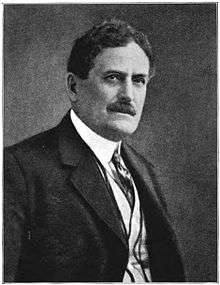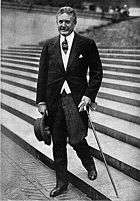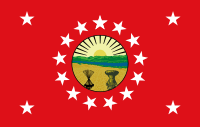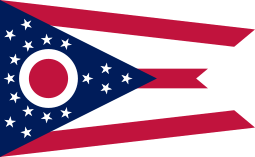Myron T. Herrick
Myron Timothy Herrick (October 9, 1854 – March 31, 1929) was a Republican politician from Ohio. He served as the 42nd Governor of Ohio.
Myron T. Herrick | |
|---|---|
 | |
| 42nd Governor of Ohio | |
| In office January 11, 1904 – January 8, 1906 | |
| Lieutenant | Warren G. Harding |
| Preceded by | George K. Nash |
| Succeeded by | John M. Pattison |
| U.S. Ambassador to France | |
| In office 1912–1914 | |
| Preceded by | Robert Bacon |
| Succeeded by | William Graves Sharp |
| In office 1921–1929 | |
| Preceded by | Hugh Campbell Wallace |
| Succeeded by | Walter Evans Edge |
| Personal details | |
| Born | Myron Timothy Herrick October 9, 1854 Lorain County, Ohio, U.S. |
| Died | March 31, 1929 (aged 74) Paris, France |
| Resting place | Lake View Cemetery, Cleveland, Ohio, U.S. |
| Political party | Republican |
| Spouse(s) | Caroline Marina Parmely |
| Children | 1 |
| Alma mater | Oberlin College Ohio Wesleyan University |
Biography
Herrick was born in Huntington, Lorain County, Ohio, the son of Mary (Hulburt) Herrick and Timothy Robinson Herrick a local farmer. He studied at Oberlin College and Ohio Wesleyan University, but graduated from neither.[1][2] He married Caroline Marina Parmely of Dayton, Ohio on June 30, 1880. They had one son, Parmely Webb Herrick (1881 – 1937).[2]
Career

Admitted to practice law in Cleveland in 1878, Herrick joined the bank Society for Savings as secretary and treasurer in 1886, and became the bank's president in 1894.[3]
From 1885 to 1888, Herrick was a member of the Cleveland City Council.[1][2] In 1886, he helped to finance the founding of The National Carbon Company, along with W. H. Lawrence, James Parmelee, and James Webb Cook Hayes (see Webb Hayes), son of U.S. President Rutherford B. Hayes, in Cleveland, Ohio.[4] This company would come to figure prominently in the history of the consumer battery and the flashlight.
Herrick was a Presidential elector in 1892 for Harrison/Reid.[5]
In 1902, Herrick gave the village of Wellington, Ohio, a grant of $20,000, which they used to build the library now known as the Herrick Memorial Library. Herrick later bequeathed $70,000 for an addition.[6]
Herrick served as the Governor of Ohio from 1904 to 1906; (future United States President) Warren G. Harding served as his Lieutenant Governor. He had been a protégé of political boss Mark Hanna, but in 1906 was defeated by the efforts of Wayne Wheeler and the Anti-Saloon League after he refused to support their plan for prohibition of alcohol in Ohio.
He subsequently served as United States Ambassador to France from 1912 to 1914 and again from 1921 to 1929. He is the only American ambassador to France with a street named after him in Paris, in the 8th arrondissement. Herrick was the ambassador who hosted Charles Lindbergh in Paris after his successful New York to Paris Atlantic crossing in 1927.[7] He was an unsuccessful candidate for the U.S. Senate in 1916 against Atlee Pomerene.
Death
Herrick was serving as United States Ambassador to France at the time of his death on March 31, 1929. He died from a heart attack.
He was interred at Lake View Cemetery in Cleveland, Ohio.[8]
References
- Wright, G. Fredrick, ed. (1916). A standard history of Lorain county, Ohio: an authentic narrative ... 1. Chicago: Lewis Publishing Co. p. 245.
- Upton, Harriet Taylor (1910). Cutler, Harry Gardner (ed.). History of the Western Reserve. 3. New York: The Lewis Publishing Company. pp. 1340–1341.
- The Book of Clevelanders: A Biographical Dictionary of Living Men of the City of Cleveland. Cleveland: The Burrows Bros. Company. 1914. pp. 129-130.
- Eveready Battery Company Records Collection at Rutherford B. Hayes Presidential Center
- Taylor 1899 : vol. 2, 136
- Village of Wellington. "Herrick Library". Retrieved September 23, 2018.
- "Ohio Governor Myron Timothy Herrick". National Governors Association. Retrieved September 29, 2012.
- Theiss, Evelyn (18 October 2009). "Former Ohio Gov. and U.S. Ambassador Myron Herrick was much beloved by French: Elegant Cleveland". Cleveland.com.
Further reading
- Taylor, William Alexander; Taylor, Aubrey Clarence (1899). Ohio statesmen and annals of progress: from the year 1788 to the year 1900 ... 2. State of Ohio. p. 136.
- Myron Herrick, Friend of France: An Autobiography by Col. T Bentley Mott
External links
| Wikimedia Commons has media related to Myron T. Herrick. |
- Myron T. Herrick at Find a Grave
- National Governors Association
- Ambassador Herrick, right, with Charles Lindbergh and Louis Bleriot; May 1927
- Myron T. Herrick Residence, formerly in Cleveland Heights, Ohio, was demolished in 1969.
- Newspaper clippings about Myron T. Herrick in the 20th Century Press Archives of the ZBW
| Party political offices | ||
|---|---|---|
| Preceded by George K. Nash |
Republican Party nominee for Governor of Ohio 1903, 1905 |
Succeeded by Andrew L. Harris |
| First | Republican nominee for U.S. Senator from Ohio (Class 1) 1916 |
Succeeded by Simeon D. Fess |
| Diplomatic posts | ||
| Preceded by Robert Bacon |
United States Ambassador to France 1914–1919 |
Succeeded by William Graves Sharp |
| Preceded by Hugh Campbell Wallace |
United States Ambassador to France 1921–1929 |
Succeeded by Walter Evans Edge |

